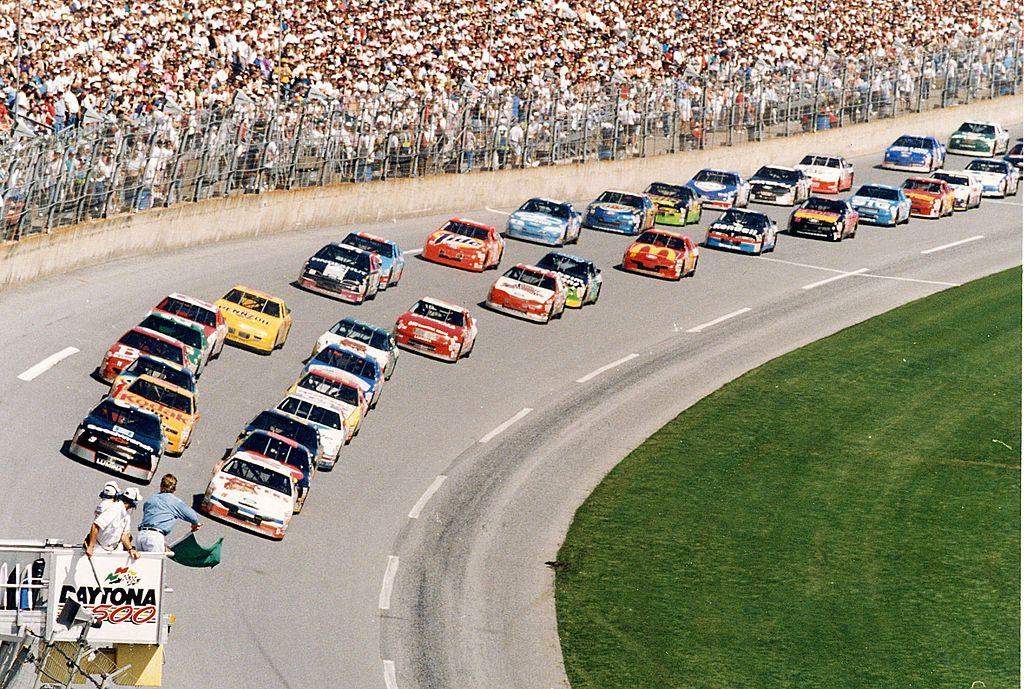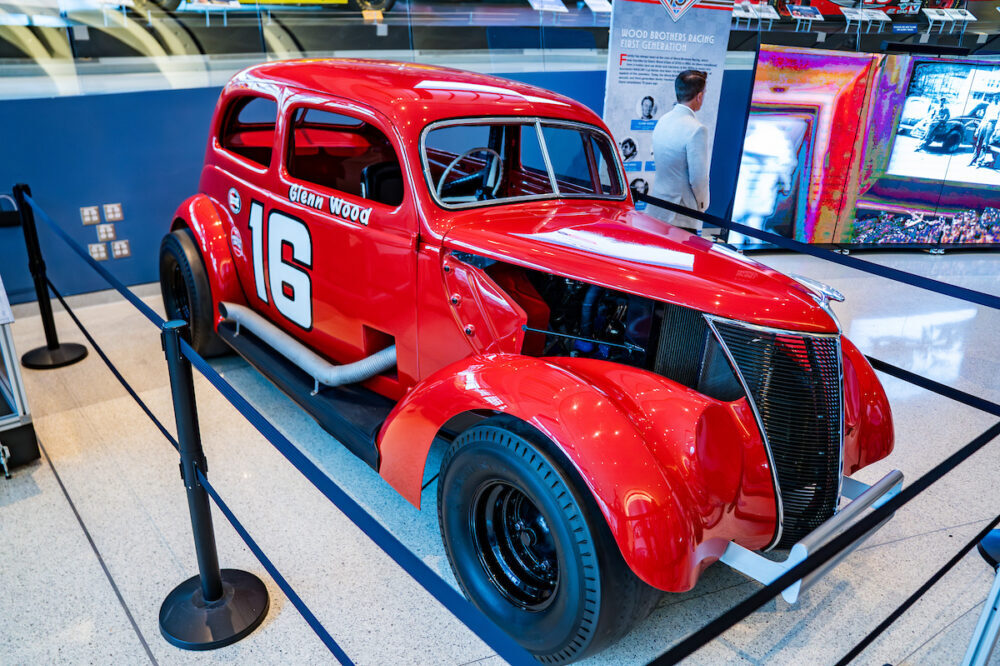First-Time Daytona 500 Winners
by Tom Jensen February 11, 2022
Even when underdogs scored their first career victories in the Daytona 500, Hall of Famers were big parts of their stories.
One of the many unique things about NASCAR compared to other professional sports is that our regular season kicks off with the year’s biggest and most important event, the Daytona 500.
Since Hall of Famer Lee Petty (2011) won the inaugural Daytona 500 in 1959, the Great American Race has more than delivered its share of electrifying moments. It’s also delivered more than its share of huge upsets.

Drivers take the green flag for the start of the 1994 Daytona 500. Photo courtesy of ISC Archives/CQ-Roll Call Group via Getty Images
A total of eight drivers scored their respective first career premier series victories by winning the Daytona 500, usually in upset fashion. That just makes sense: If you’ve never won before getting your first victory on NASCAR’s biggest almost by definition is an upset.
For each of the eight days leading up to the 2022 Daytona 500, we’ll highlight one these eight first-time winners and the Hall of Famers who played a role in the outcome of their races.

Driver Tiny Lund (left) delivered the first of five Daytona 500 victories for Wood Brothers Racing founder Glen Wood. Photo courtesy of NASCAR Archives & Research Center via Getty Images
No. 8, Tiny Lund, 1963
DeWayne “Tiny” Lund was driving into the Daytona International Speedway infield when he saw Marvin Panch’s Maserati upside down and on fire after a crash in a sports car test. Lund, 6’5” and 270 pounds, helped pull Panch from the flaming wreckage and save his life.
Panch was scheduled to run in the Daytona 500 for Wood Brothers Racing, but the burns he suffered kept him out of the race. Wood Brothers owner and Hall of Famer Glen Wood (2012), acting on Panch’s recommendation from his hospital bed, showed his gratitude by giving Lund the Daytona 500 ride in the team’s No. 21 Ford.
Wood’s brother, crew chief Leonard Wood (2013), devised a strategy for Lund to run all 500 miles on a single set of tires and to pit one time fewer than his competitors. It worked to perfection, as Lund won for the first time in 134 career premier series starts dating back to 1955.
The NASCAR Hall of Fame’s Heritage Speedway features Tiny Lund’s 1963 Daytona 500 trophy.

Race-winner Mario Andretti and his teammate and second-place finisher Fred Lorenzen lapped the field in the 1967 Daytona 500. Photo courtesy of NASCAR Archives & Research Center/CQ-Roll Call Group via Getty Images
No. 7, Mario Andretti, 1967
Ford Motor Co. had a plan for the 1967 Daytona 500: The automaker’s star driver, Hall of Famer Fred Lorenzen (2015), would win the race in the powerhouse No. 28 Holman-Moody Racing Ford Fairlane.
With a powerful engine built by Waddell Wilson (2020) and Lorenzen’s talent behind the wheel, it seemed like a done deal. There was only one problem: open-wheel star Mario Andretti in the second No. 11 Holman-Moody Ford – also with Wilson power under the hood - was even faster. At one point, Ford held Andretti in the pits to try to get Lorenzen an insurmountable lead. It didn’t work, as Andretti claimed his only NASCAR victory in just his seventh of 14 career starts.
Trivia point: Andretti’s race-winning chassis was eventually rebodied as a 1971 Mercury Cyclone, which Darrell Waltrip (2012) drove when he made his premier series debut at Talladega Superspeedway in 1972. The car carried No. 95, with sponsorship from Terminal Transport.

Maurice Petty (left) a/k/a “Chief,” built the race-winning engine and served as crew chief for Pete Hamilton in the 1970 Daytona 500. Photo courtesy of NASCAR Archives & Research Center via Getty Images
No. 6, Pete Hamilton, 1970
When Petty Enterprises rolled their pointy-nosed, high-winged Plymouth Superbirds into Daytona International Speedway for the 1970 Daytona 500, the marching orders were clear: Use the sleek Plymouth aero warriors to deliver a third victory in the Great American Race for the team’s superstar driver Richard Petty (2010).
But in a race that was reminiscent of Mario Andretti’s 1967 Daytona 500 victory ahead of Holman-Moody Racing teammate Fred Lorenzen, the 1970 plan worked out a lot better for Petty Enterprises than it did for its top driver. Richard Petty made it just seven laps before his engine failed, relegated him to a 39th-place finish in the 40-car field.
Meanwhile New England racer Pete Hamilton was paired in the No. 40 Petty Enterprises Superbird with crew chief and engine builder Maurice Petty (2014), better known to all as “Chief.” Not only did Hamilton earn his first victory in 21 career premier starts by capturing the Daytona 500, he went on to sweep both Talladega Superspeedway races later in the season.

Without a doubt, Derrike Cope (No. 10) was in the right place at the right time when Dale Earnhardt cut a right-rear tire on the last lap of the 1990 Daytona 500. Photo courtesy of NASCAR Archives & Research Center/CQ-Roll Call Group via Getty Images
No. 5, Derrike Cope, 1990
Entering the 1990 Daytona 500, Derrike Cope had competed in 71 premier series races dating back to 1982, with no victories nor top-five finishes and five top 10s, with a best result of sixth in the 1989 Champion Spark Plug 400 at Michigan International Speedway.
The 1990 Daytona 500 would prove to be Cope’s finest hour. Hall of Famer Dale Earnhardt (2010) led 155 of the first 199 laps, but as the field roared down the backstretch towards Turn 3 on the 200th and final lap, Earnhardt’s black No. 3 Richard Childress Racing Chevrolet ran over a piece of bellhousing that fell off another car and cut his right-rear tire.
Cope, who had led just four laps up until that point, inherited the lead and won his first race. Later that year, he would win again at Dover International Speedway, his second and as it turned out, final, career victory in 428 premier series starts.
The NASCAR Hall of Fame’s Heritage Speedway features Derrike Cope’s 1990 Daytona 500 trophy.

Coming to the checkered flag in the 1994 Daytona 500, Sterling Marlin was able to hold off Ernie Irvan, the man he replaced in the No. 4 Morgan-McClure Motorsports Chevrolet. Photo courtesy of NASCAR Archives & Research Center/CQ-Roll Call Group via Getty Images
No. 4, Sterling Marlin, 1994
Patience paid big dividends for Sterling Marlin in the 1994 Daytona 500. A second-generation driver from Tennessee, Marlin made his premier series debuted in the 1976 Music City USA 420 at Nashville Speedway.
But heading into the 1994 Daytona 500 some 18 years and 278 starts later, Marlin was still searching for his first career victory after eight runner-up finishes. At Daytona in ’94, though, it all came good for Marlin in a big way, as his Kodak-sponsored No. 4 Morgan-McClure Motorsports Chevrolet was fast all through Speedweeks. Marlin finished second to Dale Earnhardt (2010) in his Twin 125 qualifying race, giving him a starting spot on the outside of Row 2 for the Daytona 500.
Late in the Daytona 500, Marlin had to be careful not to burn too much fuel as he fought for the lead with former MMM driver Ernie Irvan, who was now in the fast No. 28 Ford owned by Robert Yates (2018). With 21 laps to go, Marlin made the race-winning pass on Irvan, who went on to finish second. Marline would score a repeat victory in the 1995 Daytona 500.

Dale Earnhardt Inc. teammates Michael Waltrip (No. 15) and Dale Earnhardt Jr. finished 1-2 in the 2001 Daytona 500. Photo courtesy of Robert Laberge/Allsport
No. 3, Michael Waltrip, 2001
The 2001 Daytona 500 will always be remembered with heavy hearts by NASCAR fans, as the sport’s biggest star, Dale Earnhardt (2010), perished in a last-lap crash in Turn 4, while he was running in third place.
Sweeping the top-two finishing positions were Michael Waltrip and Dale Earnhardt Jr. (2021), both driving Chevrolets fielded by Dale Earnhardt Inc., the team founded and owned by the elder Earnhardt. Waltrip’s victory was a shocker, as he came into the race winless in 462 career starts dating back to 1985. Waltrip led 27 laps, including the final 17 in scoring his first career victory.
The race was also memorable because it marked the return of Dodge to NASCAR after a 16-year absence from the sport. Dodge’s efforts were led by team owner Ray Evernham (2018), who saw one of his Dodge Intrepids driven by Bill Elliott (2015) qualify on the pole The 2001 Daytona 500 was also the first race broadcast on FOX.

Of the five Daytona 500 wins for the Wood Brothers, Trevor Bayne’s 2011 triumph was one of the most unlikely, making it all the more special. Photo courtesy of Jared C. Tilton/Getty Images for NASCAR
No. 2, Trevor Bayne, 2011
Talk about a story no one would believe if you made it up: Driving for Wood Brothers Racing, a team that began competing in NASCAR in 1950, but was only running part-time in 2011, Trevor Bayne won the Daytona 500 in one of the greatest sports upsets in history.
Bayne turned 20 years old the day before the 500, which was only his second career premier series start. For team owner Glen Wood (2012) and his brother and former crew chief Leonard Wood (2013), it was the fifth Daytona 500 win for the family owned outfit. Also, the victory was the 98th win for Wood Brothers Racing, but the first since Elliott Sadler won at Bristol Motor Speedway almost a decade earlier. Bayne took his only lead with six laps to go and held on from there.
Historical footnote: A series of attempts at a green-white-checkers finish extended the race distance to 520 miles, tied for the second longest Daytona 500 ever run.

An elated Michael McDowell celebrated his first career premier series triumph with an upset victory in the 2021 Daytona 500. Photo courtesy of Jared C. Tilton/Getty Images for NASCAR
No. 1, Michael McDowell, 2021
In a race that ran the full 200-lap distance, Arizona native and NASCAR veteran race Michael McDowell led only lap, but it was the right one: the final lap.
McDowell, driver of the No. 34 Front Row Motorsports Ford, took the white flag in third place behind Joey Logano and Brad Keselowski, teammates who drove for Roger Penske (2019). As the leaders headed towards the entrance of Turn 3 on the last lap, Keselowski made contact with Joey Logano from behind, sending both of the Team Penske entries spinning. Somehow, McDowell narrowly avoided the wrecked Penske cars, inheriting the lead. The caution flag came out a split second later, as the field wrecked behind the front-runners.
The result was McDowell’s first premier series race victory in 358 starts dating back to 2008. The victory was the third for car owner Bob Jenkins.
The NASCAR Hall of Fame Memorable Moments case features Michael McDowell’s Daytona 500 ring and A replica of the race trophy.
Plan your visit to the NASCAR Hall of Fame and purchase tickets at nascarhall.com/tickets.













